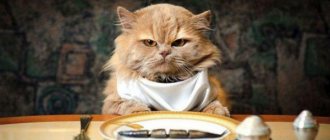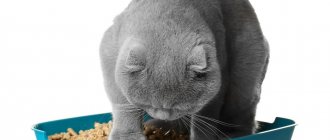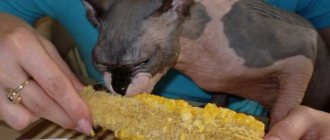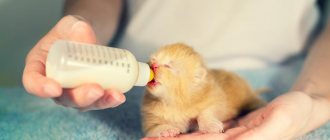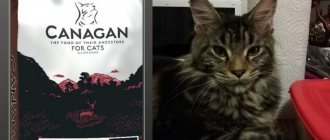The health of pets directly depends on their diet. In addition to poor-quality food, a lack of nutrients or their excess can lead to complications. For this reason, veterinarians recommend measuring the daily portion in grams.
The amount of food per day will vary for cats of different ages and activity levels. When calculating an individual portion, you will need to take into account other important factors affecting metabolism. Otherwise, your pet may suffer from obesity or dystrophy.
How much food to give a cat per day: calculating the daily portion
It is important to note that mixing dry granules and natural products is hazardous to your health. When feeding, you must stick to only one type of food, remembering to follow the recommended dosage.
Dry product
All manufacturers of dry food must place a special table on the packaging indicating how much food a cat needs per day. The calculation takes into account the age and body weight of the animal.
When choosing dry granules, take into account the individual characteristics of your pet. In a pet store you can find lines for certain breeds, pregnant, lactating and sick animals.
For example, let’s take 2 Canadian foods intended for adult cats:
| Brand | Weight, kg) | Daily serving (g) |
| Eukanuba | 2 | 32 |
| 4 | 52 | |
| 6 | 70 | |
| 8 | 93 | |
| 10 | 131 | |
| Now | 2,3-3,2 | 29-40 |
| 3,2-4,2 | 36-58 | |
| 4,5-6 | 52-96 | |
| 6-7,3 | 87-119 |
The difference in recommended volume is due to the size of the granules and their calorie content, and Now also takes into account physical activity. Because of this, focusing on some kind of average is completely pointless.
Pate or spiders
Meat pates and pouches are given in addition to dry granules or separately. The latter option is suitable for cats with dental or gastrointestinal problems.
When calculating the daily dose of wet food, as well as dry food, you should follow the instructions on the packaging. The consumption here is higher, since, unlike granules, dehydration is not used in their production. For 1 g of cat crackers there is at least 2.5 g of pate and 4.5 g of spider meat pieces.
If we carry out the calculation using Eucanuba as an example, then a 6-kilogram cat will need 175 g of pate, or 315 g of meat pieces per day. Please note that these data assume monofeeding of wet food only. When combined with granules, the dosage will be half as much.
Natural food
With natural food everything is much more complicated. Here you will have to take into account not only grams, but also the amount of proteins, fats and carbohydrates. Their percentage should correspond to the following proportion - 52:36:12.
The majority should be products of animal origin (meat, offal, fish, eggs, dairy products), and the smaller portion should be products of plant origin (cereals, vegetables, fruits).
The daily portion should be about 5% of the cat's body weight. If your pet weighs 4 kg, then it is recommended that he eat 200 g of natural food.
Despite its simplicity and convenience, this formula does not take into account a number of important factors. For this reason, it is much more reliable to calculate not grams, but the total calorie content - 90 calories per 1 kg of animal weight.
Types and classes of cat food
It is the owner who chooses food for his pet, taking into account the animal’s tastes, the presence of allergies to certain foods, as well as sensitivity to the quality of food.
There are two types of diet for cats: ready-made professional food and natural food. In addition, cat food can be: canned, wet, dry. Sometimes owners decide to buy canned food for cats, pampering their pet with a similar treat. Here it is important to adhere to the sales deadline and compliance with the composition of the canned food. Canned food can be stored in the refrigerator for a long time, but as soon as the can is opened, the contents must be consumed immediately. If the portion is smaller than the volume of a can of canned food, the excess is transferred to a glass container and stored in the refrigerator.
https://www.youtube.com/watch?v=AsH7P8ME2wk
Wet food is a cross between canned food and dry food. The bags are made for one feeding. Owners who decide, for example, to buy Arden grange for cats, should provide their pet with plenty of clean water.
By class, cat food is divided into economy, commercial, premium and super premium.
Economy class food (“Meow”, “Kitikat”, “Darling”) are cheap, but they simply suppress the feeling of hunger and do not bring any benefit, since the meat in them is replaced with soy protein. Commercial-grade food "Whiskas" and "Friskies", for example, have a quality similar to economy class. It is better not to use either the first or the second as the main diet. When it comes to the question of what food is best to feed your cat, the advice of veterinarians is clear: cheap food contains dangerous dyes and preservatives.
High quality raw materials, free of soy and grains, are used in premium and super premium food. This food contains vitamins and minerals. To fully saturate this food, a cat needs a little. These classes include food brands “Purina Pro Plan”, “Acana”, “Royal Canin”, “Bosch”, “Hill's”. The German brand Happy cat is also positioned as premium cat food.
How many calories do you need per day
The total calorie content is calculated using the following formula: K*(30*m + 70), where K is the multiplier coefficient, and m is the body weight of the animal. And if everything is clear with indicator 2, then the required coefficient value can be found in the table below.
| Physiological features | K |
| Obesity diagnosed by a veterinarian | 0,8 |
| Tendency to overeat, fraught with rapid obesity | 1 |
| Elderly age | 1,1 |
| Spayed and neutered animals | 1,2 |
| Kitten or adult pets with a small body weight | 1,2-1,4 |
| Inactive adult cat | 1,4 |
| Active adult cat | 1,6 |
| Gestation period for kittens | 1,6-2 |
| Breastfeeding period | 2-4 |
If your pet weighs 5.5 kg, constantly begs and eats everything that is not nailed down, and his furry body can hardly fit into his own house, then he will need 235 kcal per day. Please note that this is not a single portion, but a daily one. It will need to be divided by the number of feedings (usually 2).
Another example is the chicken-flavored Eukanuba. The calorie content of the granules is 4000 kcal per 1 kg, and the weight of the pack is 2 kg. That is, our hypothetical cat will have enough of this pack for 34 days (4000 kcal * 2 kg/235 kcal).
The required number of grams can be found by dividing 2 kg by 34 meals received previously. When rounded, the result is 59 g, and this figure actually fits into the standards specified by the manufacturer.
How many feedings should I divide the daily norm into?
The number of feedings per day directly depends on age. Most often eaten by kittens, which have a fast metabolism.
Kittens
For the first 2-2.5 months, kittens feed on breast milk. Complementary feeding begins only at 3-4 weeks, when the furry babies have baby teeth. But, if your pets are left without a mother too early, then you will have to think about the feeding regime soon after their birth.
The main recommendations can be found using the table:
| Age | Feeding frequency |
| Less than 3 weeks | Every 2-3 hours, that is, about 7-8 times a day without night breaks |
| 3 weeks – 1.5 months | 6-7 times a day with a night break within 5 hours |
| 1.5-2 months | 6 times a day |
| 2-3 months | 5 times a day |
| 3-6 months | 4 times a day |
| 6-8 months | 2-3 times a day |
After reaching 6-8 months, the diet and feeding regime gradually approaches that of an adult. At this point, pets reach puberty.
Adults and elderly animals
Adult cats are fed twice a day, while older cats (over 7 years old) are fed only once a day. Your veterinarian can make changes to this regimen.
Most often, the number of meals is increased in case of gastrointestinal diseases, when the stomach and intestines are unable to digest too large volumes. By reducing the single portion, it is possible to reduce the load on these organs.
When should you increase/decrease the rate?
Adjustment of the norm is necessary for obvious signs of obesity or underweight. A number of physiological characteristics (most of them were mentioned when calculating the coefficient for determining caloric content) and external factors should also be taken into account.
Physical activity
Active pets with constant access to the outdoors expend much more energy than their furry counterparts lounging on the couch. For this reason, they need to eat more than usual in order not to lose their muscle mass and stay healthy. Often 15% of the total portion is added to the daily intake of active pets.
Age
Growing kittens can boast of fast metabolism. The food they eat is spent on building the skeleton, muscles and other equally important tissues. Because of this, they rarely gain weight and constantly want to eat.
It's different for older animals. With age, all internal processes slow down. The quality of teeth and gums deteriorates. Food becomes more difficult to chew, and the usual volumes increasingly remain untouched. The activity of such cats is very low, so less and less calories are required to maintain the body.
Restructuring the body after castration or sterilization
After surgery, the animal's hormonal background undergoes a number of changes. Despite the slowdown in metabolism and loss of usual activity, appetite remains the same or even increases.
Due to lack of saturation, a neutered cat quickly gains excess weight. Without owner intervention, it may suffer from obesity and other pathologies associated with this disorder.
In addition to reducing calories, it is recommended to switch to a special ready-made diet for sterilized animals. It has a moderate amount of fat and carbohydrates, and also helps speed up metabolism and maintain muscle mass.
Pregnancy and lactation
From the table above you can see that pregnant and lactating cats require the most calories. At 2 weeks of pregnancy, the volume of food should be increased by 10-15%, and at 3 – by 50%.
After the kittens are born, the caloric content of the diet is again increased so that the mother has enough nutrients for both herself and the cubs. It is better to consult a veterinarian about the exact numbers, since the number of babies and the volume of milk play a big role.
External factors
The need for food is directly related to weather conditions. In winter, a lot of energy is used to heat the body, so to replenish it you have to eat more than usual. In summer, the situation is reversed, so don’t be surprised if your pet once again ignores his favorite treat, but drinks cool water with pleasure.
Complete refusal of food is one of the symptoms of infections, parasitic infestations and systemic pathologies. Due to intoxication, inflammatory processes and dysfunction of internal organs, the need for food is significantly reduced. You can suspect something is wrong by the accompanying symptoms: vomiting, diarrhea or constipation, itching, fever, cough, strange discharge from the nose or eyes.
Disadvantages of feeding cats wet food
All pets, including felines, need proper and balanced nutrition.
Many veterinarians recommend using food that is specifically made for cats.
The positive aspects of this feeding method include the following:
- practicality;
- convenience;
- efficiency.
It is the last argument that often becomes decisive. The fact is that if you purchase all the ingredients contained in a ready-made mixture for feeding cats separately, it will not be cheap.
Practicality and ease of use are also important advantages. Owners just need to open a pack or canned food with ready-made food and put the contents in a bowl. There is no need to waste time and effort preparing food. Fill the bowl and go about your business.
READ Sugar glider - care and maintenance at home
Another important advantage of the ready-made mixture that can be fed to cats is its balance. This food is prepared based on the recommendations and research of veterinarians.
This means that it already contains all the necessary nutrients, trace elements and vitamins. In addition, mixtures are produced that can be fed to kittens or adults. After all, at every age an animal needs its own diet.
But this method of feeding your pet also has some disadvantages. First of all, it is worth mentioning the wide range of cat food.
On the one hand, having a choice is good, but on the other hand, it is an opportunity to make the wrong choice. Very often, manufacturers spend more money on advertising their products rather than on their quality.
Many veterinarians have some concerns about the food that is produced in our country. Quite often, expensive ingredients are replaced with cheap ones.
For example, the packaging may say that the dry mixture contains meat, but in fact, ground bones, tendons or other “waste” from meat production are added to it. Therefore, you should be careful when choosing the mixtures that you will feed your cat.
In addition, some cats may be allergic to ready-made food mixtures. In this case, you can either try different options (and your pet will suffer) or feed the animal natural food.
- Many owners have noticed that their pet drinks little and does not consume the recommended amount of water even in hot weather. This can lead to negative health consequences. Wet food contains sufficient water. Thanks to this, the animal receives not only healthy nutrition, but also a sufficient amount of fluid.
- Feeding your cat wet food is convenient. It does not require additional processing before use. Therefore, in order to prepare a complete breakfast, lunch or dinner for your pet, you do not need to waste time cooking porridge, stewing vegetables separately, or pouring boiling water over chicken fillet. Simply open the jar and put the contents in the cat’s bowl.
- Wet food is divided into special lines, which take into account all the necessary age characteristics of pets. Veterinarians recommend feeding wet food to sick and weakened cats after surgery and during the rehabilitation period.
- Canned food is easy to transport, it does not spoil and takes up little space. Therefore, if you need to go somewhere with your pet, then he will not have to change his taste preferences in a new place. You can always feed your cat her favorite wet food that she is used to.
- There are many types of wet food, so you can always add variety to the menu - pates, meat stews, pieces in a delicate sauce, etc.
- short shelf life when opened;
- You cannot feed your cat wet food straight from the refrigerator; you must wait for it to warm up to room temperature;
- high consumption. If you previously fed your cat dry food and now switched to wet food, the difference in product consumption will increase several times.
To find out which wet food is best for your cat, whether a mixed type of diet is possible for her, and how to feed her correctly in this case, you need to consult a veterinarian.
Source
Some may suspect that this is ordinary food, but with different labels on the packaging. In fact, we are talking about truly special foods intended for the mentioned types, and such foods differ in composition. For example, food for active cats is higher in calories, since active animals spend a lot of energy, while food for lazy couch potatoes is lighter.
– You need to look at the bag of food for castrated or sterilized animals to see if, for example, it contains L-carnitine. This is a fat burner, which is important for somewhat passive cats prone to weight gain, explains Galina Chernova.
Cats, being predators by nature, are designed in such a way that for the normal functioning of all body systems they need protein food. Meat, bones and entrails of captured animals are the only source of food for the wild brothers of domestic cats.
The latter, who have been living side by side with humans for thousands of years, will not experience a lack of nutrients, taking advantage of the fruits of their hunt for mice and rats.
Raw meat is a supplier of energy, responsible for cell growth, the state of the immune system, and is responsible for reproductive and other functions of the body. Animal protein contains essential amino acids that cats cannot synthesize on their own.
Taurine is an amino acid that cats do not produce in their bodies like some others, and it only comes from meat products. Taurine is responsible for vision and cardiac activity, helps in digestion processes. Taurine is added artificially to industrially produced cat food.
Kitten development
Young cats, just like adults, need protein components. In fact, kittens require even more animal protein than cats due to their vigorous growth.
Kittens go through several stages during their development:
- newborns;
- milk period;
- first feeding;
- stage of socialization.
About a month passes from the moment of birth until the start of complementary feeding. In nature, all this time the mother cat feeds her offspring with milk. But there comes a period when there is not enough milk for everyone - the mother brings the remains of prey to the den or regurgitates the meat in a semi-digested form. In the life of domestic cats, this time is characterized by the introduction of semi-liquid food into the kittens’ diet.
It is knowledge about the feeding behavior of cats in nature that will help determine what will be useful for pets, whose diet and health depend entirely on the owner.
How can you tell if an animal is undernourished or overfed?
All mustachioed pets can be divided into 2 groups: picky and glutton. Only a few eat their quota, so owners have to monitor the health of their pets by regularly measuring body weight.
Weight control
You can control your weight using scales or visually. In the first case, the pet must be weighed every week so as not to miss deviations. With an increase in body weight, the calculated dose is reduced, and with a decrease, it is increased.
For visual assessment, palpation of the ribs and spine is used. They should be easily palpable, but not protruding. If they are hidden by a layer of fat, the cat needs to be put on a diet. If the situation is the opposite, then, most likely, other alarming signs will be observed: lethargy, hair loss and abdominal collapse.
If your pet is constantly begging
When fighting begging, you need to show persistence and steadfastness. To begin with, you should refuse to feed on your pet’s command. Don't buy into his pitiful cries and unhappy eyes. If the weight is within the normal range or above, then a daily portion is more than enough for him.
Particular attention should be paid to the regime. Feed your mustachioed beggar at certain hours and do not deviate from the schedule. The breaks between meals should be approximately the same.
It is also recommended to temporarily give up treats and be sure to replace cheap dry granules with flavors with a less attractive, but more healthy analogue of at least a premium class. Over time, the animal will understand that its tricks do not work and will calm down.
How to feed
When choosing cat food - dry or wet - you should be guided by the composition. Wet food for cats, the best in composition, should contain primarily meat: the more of it, the better the quality of the food and the more effective it will be for the health of the pet.
Proper nutrition is the key to your pet’s health
Among the elements of natural products you need to add:
- vegetables. It is a valuable source of vitamins and microelements, as well as fiber. They support digestion and increase the nutritional value of food;
- eggs. In some cat foods, eggs are an additional source of protein. In addition to this, they also contain vitamin A, D, iron and polyunsaturated fatty acids;
- taurine is an amino acid found in meat that is essential for keeping your cat healthy. Promotes the proper functioning of the heart and digestive system. In addition, it plays an important role in building immunity and the functioning of the animal’s nervous system;
- vitamins, minerals, trace elements have a beneficial effect on the condition of the cat’s skin, coat and general well-being.
When planning your cat's or kitten's diet, it is important to consider that a good wet food should not contain cereal, sugar, preservatives or artificial colors and flavors. The simple composition and many useful nutrients will allow the cat to live a long time and not get sick.
Useful tips for cat owners
In conclusion, it is worth noting a few more nuances. They relate to the drinking regime and measuring the required number of grams.
Drinking regime
Water plays a huge role in the life of every organism. To maintain metabolic processes, you need to regularly drink your daily fluid intake. For adult representatives of the cat family it is 31.5 ml per 1 kg, and for kittens – 77 ml per 1 kg.
Please note that the body receives part of the fluid from food. For this reason, the recommended indicator may deviate more or less for different types of nutrition.
In addition to volume, you need to take care of quality. Tap water contains a lot of salts and metals, so drinking it increases the likelihood of developing urolithiasis. Instead, you should give bottled water or use a special filter. It is recommended to change the water 1-2 times a day, since otherwise pathogenic microorganisms begin to actively multiply in it.
How to measure the right portion
The easiest way is to use a kitchen scale. If they are not there, then you can purchase a special measuring cup at the pet store along with the food. Sometimes it comes included for free. The scales indicated on it will differ for different manufacturers, so when switching to a new brand, it is recommended to change the cup to a new one.
Another way is to weigh yourself in the store. Most of them have checkweighers for selling food in bulk. You can ask the seller to package the package into portions or measure out at least one of them. In the second case, after returning home, transfer the granules into any glass, make a mark with a permanent marker and use it as a guide when dispensing food later.
Conclusion
The amount of food for a cat depends on its physiological characteristics and external factors, so the daily intake should be calculated individually. For accurate indicators, use the formula for calculating calories.
The article is a recommendation!
